Статьи журнала - Журнал стресс-физиологии и биохимии
Все статьи: 984
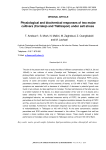
Статья научная
The aim of the present work was to study the effect of different concentrations of NaCl (0, 50 and 100mM) in two cultivars of maize (Corralejo and Tlaltizapan), on their nutritional and photosynthetic comportment. The measures focused on the physiological parameters (growth weight, hydration and nutritional status of plants) and biochemical (chlorophyll, PEPC activity, activity of some anti-oxidant enzymes and lipid peroxidation). Analysis of morphological parameters showed a yellowing of the extremity of leaves, at 100 mM of NaCl. These visual symptoms are associated with a decrease of chlorophyll. A decrease in potential growth was found in two cultivars, but less significant in Corralejo. The best salt tolerance of the latter was due to a better hydration of the leaves, to a lesser accumulation of Na + and Cl - in its leaves and a better selectivity K/Na. To identify the biochemical characteristics associated with the physiological behavior, we conducted measures activity of PEPC, the protein, catalase and peroxidase on the fourth leaf from the bottom. A negative correlation between the activity of PEPC and Na+ amount was found at 50 mM in the sensitive cultivar and at 100 mM of NaCl in tolerant cultivar Corralejo. Furthermore, the antioxidant response was marked by a greater accumulation of malondialdehyde, in Tlaltizapan at 100 mM of NaCl. At the same concentration, catalase peroxidase and SOD activities weren't decreased in this cultivar. This suggests that salt has created a stress oxidative state only in Tlaltizapan leaves. These results showed a better performance of Corralejo cultivar compared to Tlaltizapan cultivar, at 50 and 100 mM of NaCl.
Бесплатно
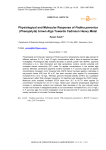
Статья научная
Physiological and molecular response of Padina pavonica (phaeophyta) marine alga exposed to different cadmium (0, 2.5, 5 and 10 mg/L) concentrations after 4 days of exposure has been investigated. Physiological data revealed decrease in specific growth rate (SGR%), pigments (Chlorophyll a & b , total chlorophyll and total carotendois) content, osmotic potential with increased electric conductivity (EC) under Cd applied concentrations in the studied alga species. Whereas, carotendois pigments content increased in P. pavonica alga as Cd applied concentrations increased. As for molecular test, RAPD marker has been applied, a decrease in polymorphic bands (PB) from 95 to 87 has been recorded when applied Cd concentration increased from 2.5 to 10 mg/L. Whereas, genomic template stability (GTS%) as a qualitative measurement reflect DNA changes induced by Cd treatment was displayed by RAPD marker. Molecular study revealed increased GTS% value from 30.7 to 42.7% when applied Cd concentration increased from 2.5 to 10 mg/L. Based upon observed physiological (significant increase in carotendois content) and molecular data (decrease in the new induced bands number and increase in disappeared bands as Cd concentration increased from 2.5 to 10 mg/L) in P. pavonica alga, the current investigation could be assumed that P. pavonica alga adopted certain mechanism to minimize Cd stress damages.
Бесплатно
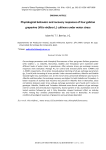
Статья научная
Gas exchange parameters and chlorophyll fluorescence of four pot grown Galician grapevines (Vitis vinifera L. cv. Albariño, Brancellao, Godello and Treixadura) were examined under different levels of water stress in greenhouse. After extreme stress, gas exchange recovery responses were evaluated. Average ΨPD for control and stressed plants were -0.4MPa and -1.45MPa respectively. All varieties showed gradual declining of all gas exchange parameters (gs, E and A) with increasing of stress periods. Under stressed conditions, Albariño and Godello showed higher CO2 assimilation rate. At the end of stress period leaf defoliation was found in Albariño and Brancellao. Gas exchange recovery was higher for both Godello and Treixadura. A better response of auxiliary bud recovery was present in Albariño than in Brancellao. Close correlations between water stress and gas exchange parameters were found and it varies on genotype. Albariño, Godello and Treixadura followed same diurnal patterns of gas exchange rate for control and stressed plant respectively. Diurnal pattern of CO2 assimilation rate of all tested varieties followed gs and E. Only Brancellao showed treatment effect on mid-day Fv/Fm. Among four varieties photoinhibition was only found in Brancellao. At stressed condition physiological responses of grapevines were genotype depended.
Бесплатно
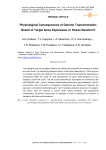
Статья научная
The transgenic and non-transgenic tobacco cell cultures were analyzed for resistance to abiotic and biotic stress. The different physiological reaction of cell culture depending on T-DNA structure (or transgen structure) was observed. The cell culture transformed by disarmed Agrobacterium tumefaciense A699 with pCNL 65 nptII demonstrated the same stress-resistance as non-transgenic control cell culture. The cell culture transformed by Agrobacterium tumefaciense LBA 4400 pBiCaMV nptII + hsp101 showed a raised stress-resistance to high temperature, high KF concentration, and to the action of Clavibacter michiganensis ssp sepidonicus. Obviously, the expression of transferred arabodopsis gene hsp101 provides protection properties of transgenic cell culture under the influence of various stress factors. Moreover, that agrobacterial transformation as previous stress-factor is supposed to make a contribution to formation of transgenic cell culture cross-resistance.
Бесплатно
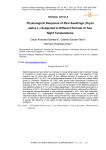
Статья научная
Night temperatures have shown an increase in rice-growing regions due to climate change in Colombia in recent years, causing a reduction in grain yield. The objective of this research was to study the effect of four different periods of exposure to two night temperatures (24°C vs. 30°C) on the physiological behavior of an Indica rice cultivar widely grown in Colombia. Fedearroz 60 (ʻF60ʼ) were grown under greenhouse conditions for forty-five days. After this period, 12 plants in each treatment was established in a growth chamber at 30°C from 18:00 to 24:00 to carry out the duration of the different periods of heat nighttime stress (4, 8, 12, and 16 days respectively). The control plants were kept in a greenhouse at 24°C. The results showed that leaf photosynthesis, carboxylation efficiency, and pigment content decreased in rice seedlings subjected to 30°C. Also, dark respiration and intercellular CO2 concentration increased. These reductions in the variables as mentioned above were more severe during the first four days of exposure to 30°C than 24°C. In conclusion, these results suggest that these physiological variables may be useful to assess the tolerance of rice plants to high nighttime temperatures in plant breeding programs.
Бесплатно
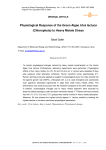
Physiological response of the green algae Ulva lactuca (Chlorophyta) to heavy metals stress
Статья научная
To monitor physiological changes induced by heavy metals contamination on the marine algae Ulva lactuca (Chlorophyta), laboratory experiments were performed. Physiological effects of four heavy metals (Cu, Pb, Zn and Cd ions) on U. lactuca were assessed 5 days after exposure under laboratory conditions. Fourier transform raman spectroscopy (FT-Raman) technique was also applied as support for physiological study. Our data showed that the specific growth rate (SGR%), chlorophyll (Chl a & b ), total chlorophyll and carotenoids (Car) pigments decreased significantly in algal thalli under heavy metals stress. This phenomenon was more pronounced with Pb treatment compared to the other tested metals. In addition, morphological changes due to heavy metals treatment were recorded by observed cellular damages under the above mentioned metals. FT-Raman technique showed that the C-H, C=O, CH 2 and C-O-C groups were mainly involved in heavy metals absorption. Moreover, Pb ions showed the highest toxicity against U. lactuca studied by showing the highest decline in the above mentioned physiological parameters.
Бесплатно
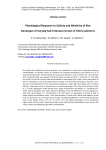
Статья научная
Soil salinity and alkalinity seriously threaten rice production in south Asia. Improving screening methodologies to identify sources of tolerance for improved breeding for salt tolerant rice is of continuing importance. Rice genotypes of varying salt tolerance, such as tolerant (T), semi-tolerant (ST), and sensitive (S), were grown in field lysimeters in saline soil of EC e 4 and 8 mS cm -1 and alkali soil of pH 2 9.5 and 9.8 in North India and analyzed for chlorophyll (Chl), sugar, starch and proline in leaves. Chlorophyll a and b decreased due to salinity in all the tolerance groups. However, Chl a was not much affected but chl b increased with alkalinity. Under high stress both at EC e 8 and pH 2 9.8 Chl a and b were more in tolerant than in sensitive genotypes. The ratio of Chl a/b was similar in T, ST and S genotypes under salinity stress. Sugar accumulation was higher in T compared to S under normal conditions but under salinity or alkalinity stress the differences were not significant. Leaf starch was highest in T, intermediate in ST and lowest in S genotypes in normal as well as under salinity and alkalinity stress. There was decrease in starch with salinity and alkalinity stress only in T group but not in ST and S group. Proline increased significantly in all the tolerance groups even at low salinity of EC e 4 mS cm -1 or pH 2 9.5. The salt tolerant genotypes of rice maintained higher levels of Chl a and b, starch and proline under high salinity and alkalinity stress are thus robust criteria for tolerating high salinity and alkalinity.
Бесплатно

Статья научная
Salvinia natans L. a water fern is displayed with some of its physiological attributes in response to aluminium (Al) stress in aqua culture as well as its interaction with externally applied putrescine (put). At the tissue level the Al deposition is prominent and mostly distributed in the intracellular spaces as well as cellular interfaces. The accumulation of Al and its induced oxidative damages are also revealed through Evan’s blue staining. In both the cases dose dependent responses of Al induced oxidative damages and its mitigation with Put was the resultant. Under non enzymatic antioxidation pathways, anthocyanin and flavonoids were the two phenolics over expressed as a function of Al and ameliorated with Put application. The property of root membranes was changed with an up regulation of H +/ATPase activity which was moderated by Put.The peroxidase activity particularly those were restricted to the wall bound also showed variability according to Al doses as revealed through in gel staining. From these studies of Al accumulation and its concomitant changes in physiological attributes in Salvinia plants, the species could be selected as a potential hyper accumulator of Al. The role of Put in Al accumulation as well as its moderation has been discussed with reference to physiological activities.
Бесплатно
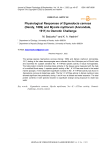
Статья научная
The sponge species Sigmadocia carnosa (Dendy, 1889) and Mycale mytilorum (Annandale, 1911) belong to the class demospongiae were collected from the Vizhinjam port of South India and examined for ouabain sensitive Na+, K+-ATPase specific activity in tissue homogenates. The total protein contents including stress proteins in the tissues were measured with the help of a modified Biuret assay. A species specific activity of Na+, K+-ATPase was found in the tested marine sponges. A time dependent significant increase in Na+, K+-ATPase activity was found in Sigmadocia carnosa at diluted sea water. The Na+, K+-ATPase activity in Mycale mytilorum also showed significant rise particularly during 1 and 4 hour at diluted sea water exposure. The total protein contents in both species showed no significant change during exposure to dilute sea water.
Бесплатно
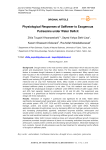
Physiological responses of safflower to exogenous putrescine under water deficit
Статья научная
Background: Drought stress is the most common abiotic stress factor which reduces the plant growth and development more than other factors. For this reason, identification of effective factors to increase drought tolerance of plants is necessary requirement. Many reports have been focused on the involvement of polyamines in plant response to abiotic stresses such as drought. Polyamines as growth regulators play important roles in keeping cell membrane stability and reducing ROS generation under water deficit. Carthamus tinctorius is an industrial, medicinal and oil crop from Asteraceae family. Many studies in other plants showed that polyamines increase tolerance to environmental stresses, but physiological responses of water-stressed safflower plants to putrescine is not clear. Thus, this research was carried out to investigate the physiological changes in safflower under different levels of water supply (100% and 40% field capacity) treated by putrescine (0, 40 and 60 µM)...
Бесплатно
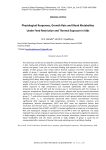
Статья научная
The study was carried out to study the cumulative effect of thermal stress and feed restriction in kids. Twelve kids of Alpine x Beetle cross were divided into two groups. Group 1 served as control and group 2 was put on restricted feeding and exposed at 40, 42 and 44 oC. Body weights of both groups were similar before thermal exposure and feed restriction. Body weight of group 1 increased significantly and were higher than group 2 throughout the experiment. Body weight gain, average daily gain and feed conversion efficiency were comparable in both groups after removal of thermal stress and switching over to ad libitum feeding (42-63 days). Body weights of group 2 remained lower than group 1, the losses in body weights of group 2 could not be compensated and there was approximately 25% loss in body weight at the end of experiment. Physiological responses of group 2 were significantly lower before exposure to high temperature but increased significantly after exposure at temperature 40, 42 and 44 oC and the increase was in commensurate with the increase in exposure temperature. Blood glucose, total protein, albumin and serum enzymes decreased significantly on exposure at higher temperature and differences were higher in feed restricted group. T 3, T 4 and cortisol concentration were similar in both groups before feed restriction and thermal stress. T 3, T 4 concentration decreased while cortisol concentration increased significantly after exposure to high temperature. Variations in plasma enzymes, acid phosphatase, alkaline phosphatase, SGOT and SGPT were not significant before feed restriction and thermal stress. The activities of acid phosphatase and alkaline phosphatase decreased whereas that of SGOT and SGPT increased significantly on exposure at temperature 40 oC and subsequent changes at temperature 42 and 44 oC were not significant. The study indicated that animals of group 2 experienced more stress as observed by significant alteration in body weights, physiological responses, serum enzymes, electrolytes, plasma hormones and blood metabolites and the losses occurred in body weights of group 2 could not be compensated after removal of thermal stress and switching over to ad libitum feeding.
Бесплатно
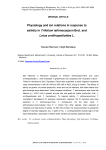
Статья научная
Salt tolerance in Moroccan ecotypes of Trifolium isthmocarpum Brot. and Lotus ornithopodioides L. were evaluated in greenhouse and compared with Australian cultivar : Trifolium michelianum Savi. Paradana. Plants were submitted to three irrigation treatments using concentrations 0 mM, 80 mM and 200 mM of NaCl, during 3 months. The effects of salinity on growth, dry matter production, shoot and root ion relations, leaf water relation and gas exchange were determined. Under stressed conditions, T. isthmocarpum was more salt tolerant (p - exclusion mechanism. However, the Cl - exclusion was more important in T. isthmocarpum than T. michelianum. On the other hand, T. isthmocarpum accumulated more K + in shoots than other species, when exposed to moderate and high levels of salinity. At 200 mM of NaCl, the stress promoted a substantial degree of stomatal regulation; but, in spite of this, L. ornithopodioides showed signs of leaf tissue dehydration, decreases in relative water content and osmotic potential values.
Бесплатно
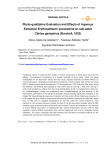
Статья научная
Traditional means of capturing fish dwells on active components in plant which elicit harmful effects. Erythrophleum suaveolens is a typical example of such plant, which the study investigated for its stem-back (ASE) and leaf (ALE) aqueous extracts sub-lethal effects on Clarias gariepinus . Qualitative phytochemical screening of both extracts was carried out using 300 C. gariepinus sub-adults maintained in 10-fish sample per 1000 L circular fibre tanks during the research; the extracts were applied on every other day at 0.23 mg/ L ASE and 0.26 mg/ L ALE, which elicited LC50 effects from the range finding tests, for 96 h compared with control set-up. Haematological (during the experiment) and histopathological (at the terminal of the experiment) parameters of the fish were analysed. Results showed significant variations in the treated fish haematological responses compared with the control. More impact was observed in ALE treated fish and linked to three active components (phenols, saponins and steroids) higher than in ASE, with no negative observations on the fish under the control treatments...
Бесплатно
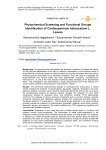
Phytochemical Screening and Functional Groups Identification of Cardiospermum halicacabum L. Leaves
Статья научная
Background: The phytochemical components are extremely important to facilitate the search for the particular effectiveness of the plant in medicine. Identification of the chemical nature of phytochemical compounds present in medicinal plants will provide information about the various functional groups responsible for its medicinal properties. Thus, the need to investigate the phytochemicals from various plants has been exponentially increasing. Cardiospermum halicacabum L. is one of the most important medicinal plants belonging to the Sapindaceae family. This investigation was administered to study phytochemical and FT-IR analysis of a various solvent extracts of Cardiospermum halicacabum L. leaves. Results: The preliminary phytochemical analysis of Cardiospermum halicacabum L. leaves extract revealed the presence of carbohydrates, glycosides, alkaloids, phytosterol, fixed oils, saponins, proteins, and amino acids, phenolic compounds, flavonoids, and tannins. As a result, the phytochemical analysis of aqueous extracts revealed the presence of more phyto components followed by petroleum ether, and chloroform extracts. FT-IR spectroscopy confirmed the existence of various chemical components such as alcohol, alkanes, aromatic compound, carboxylic acid, aldehydes, alkenes, amides, nitro compounds and alkyl halides in the leaves extract of C. halicacabum L. The functional groups observed in the various extracts probably indicate the presence of carbohydrates, glycosides, alkaloids, amino acids, phenols, flavonoids, tannins, and saponins. The results obtained from FTIR analysis are significant with the preliminary qualitative analysis. Conclusions: Extractions of any crude drug with a certain solvent result in a solution that contains various phyto-components. The composition of these phyto-components in the respective solvent provides initial information about the quality of a drug sample. The presence or absence of a certain component plays an important role in the decision about the medicinal properties of the plant. As a result, the phytochemical analysis of aqueous extracts revealed the presence of more phyto-components followed by petroleum ether, and chloroform extracts which can be beneficial in a therapeutic approach.
Бесплатно
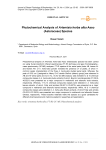
Phytochemical analysis of Artemisia herba alba asso (Asteraceae) species
Статья научная
Phytochemical analysis of Artemisia herba-alba Asso (Asteraceae) species has been carried out using fourier-transform infrared spectroscopy (FT-IR) technique and gas chromatography-mass spectrometry (GC-MS) analyses. FT-IR spectra of the aerial parts (buds AB, leaves AL and flowers AF) of A. herba-alba powder revealed the presence of 12 peaks, of which 11 common peaks characteristics of the three A. herba-alba studied aerial parts. Whereas, the peak of 1632 cm-1 [(assigned to Alkenyl C=C stretch-Olefinic (alkene) group)] was observed in AB and AF aerial parts and not in AL. As for GC-MS analysis, data revealed 12 & 10 chemical compounds classes in A. herba-alba buds extracts of which, Bicyclic monoterpenoids (37.026 & 49.022%) was presented as a major compound in methanolic and ethanolic buds extracts, respectively. Whereas, 17 & 14 chemical compounds classes were detected in A. herba-alba leaves extracts, of which, Fatty acid amides (28.687 & 25.687%) was presented as a major compound in methanolic and ethanolic leaves extracts, respectively. While, 16 & 11 chemical compounds classes were detected in A. herba-alba flowers extracts, of which Fatty acid amides (25.623 & 23.295%) was presented as a major compound in methanolic and ethanolic flowers extracts, respectively. These bioactive materials make this species as a good candidates for different pharmaceutical and medicine academic researches and applications.
Бесплатно
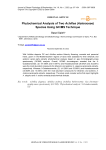
Phytochemical analysis of two Achillea (Asteraceae) species using GC/MS technique
Статья научная
Wild Achillea aleppica DC and Achillea arabica Kotschy flowering, aromatic and perennial herbs, grown in the Middle-Southern regions of Syria were assessed for their ethanolic and acetonic aerial parts extracts phytochemical analysis based on gas chromatography-mass spectrometry (GC/MS) analysis. Overall, GC/MS chromatogram revealed that the 9-Octadecenamide, (Z)- (41.656% and 61.097%) and Hexadecanamide (36.542% and 20.238%) were the most abundant compounds for ethanolic and acetonic A. aleppica aerial parts extracts, respectively. Whereas, 9-Octadecenamide, (Z)- (41.280% and 53.990%) and Hexadecanamide (30.828% and 14.445%) were the most abundant compounds for ethanolic and acetonic A. Arabica aerial parts extracts, respectively. This study could consider as the first report highlights A. aleppica and A. arabica extracts phytochemical analysis.
Бесплатно
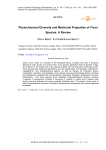
Phytochemical diversity and medicinal properties of Ficus species: a review
Статья обзорная
Genus Ficus , which is a member of the Moraceae family, includes more than a thousand species of vines, shrubs, and woody trees. Ficus species, generally known as fig trees or figs, are endemic to the tropics and a few species expand into the semi-warm temperate zones. Ficus species have traditional applications such as expectorants, mild laxatives, anthelmintic, hypoglycemic, and antihypertensive agents, as well as therapy for rheumatic illness, constipation, dysentery, and dyspepsia. Ficus species have several biological actions, including anti-hypertensive, hypoglycemic, neuroprotective, antioxidant, analgesic, antibacterial, and anti-inflammatory and some species show antidibetic properties.Several species, including F. religiosa, F. bengalensis, F.hispida, F. racemosa, F. curtipes, F. rumphi, and F. elastica , have strong economic potential and having potential medicinal uses. This present review aims to offer a comprehensive overview of the plant's phytochemical components and various medicinal properties.
Бесплатно
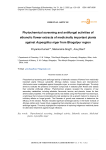
Статья научная
Phytochemical screening and antifungal activity of ethanolic extracts of flowers from medicinally important plants Hibiscus sabdariffa , Moringa oleifera , Cassia fistula and Clerodendrum Infortunatum were investigated against Aspergillus niger , a common fungal pathogen. The study aimed to evaluate the presence of bioactive compounds in selected plant flowers and assess their potential antifungal efficacy. Phytochemical analysis revealed the presence of key secondary metabolites, including alkaloids, flavonoids, tannins, and phenols, known for their antimicrobial properties. The antifungal activity was tested using the Poisoned Food technique, a technique that involves incorporating the test substance into a growth medium to observe its inhibitory effects on fungal growth. The Diameter of growth was measured to determine the efficacy of the extracts. Results indicated significant antifungal activity in the flower extracts of Moringa oleifera and Cassia fistula , suggesting their potential use in the development of natural antifungal agents. This study highlights the importance of exploring indigenous medicinal plants for alternative treatments against fungal infections.
Бесплатно
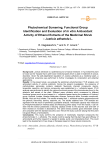
Статья научная
Background: Justicia adhatoda is a potential source of natural medicine . In Ayurveda this plant is known as the ‘Vasaka’ that is well known medicinal plant which is used in treatment of various disorders. Given the well-established reputation of Justicia adhatoda as a medicinal plant, a phytochemical screening was performed to further investigate its composition and potential applications.
Бесплатно
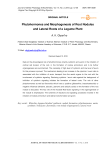
Phytohormones and morphogenesis of root nodules and lateral roots of a legume plant
Статья обзорная
Data on the physiological role of phytohormones (mainly cytokinin and auxin) in the initiation of cortical cell division of the root, in the formation of nodule primordium and in its further organogenesis are summarized. The necessity of high level of cytokinin and low level of auxin for this process is proved. The mechanism leading to an increase in the cytokinin / auxin ratio is associated with the inhibition of auxin transport from the aerial organs to the root with the involvement of cytokinin signaling. Reducing cytokinin / auxin ratio against the background of inhibition of cytokinin signaling initiates the formation of lateral roots. The role of other phytohormones as well as flavonoids which have a positive (gibberellins, brassinosteroids) or negative influence (ethylene, abscisic, jasmonic and salicylic acids) on the formation of the root nodule is discussed. The key role of the rhizobial Nod factor signaling in the organogenesis of the nodule is emphasized. The schemes of reactions and signaling processes involved in the initiation of nodule primordium and lateral roots formation are given.
Бесплатно

